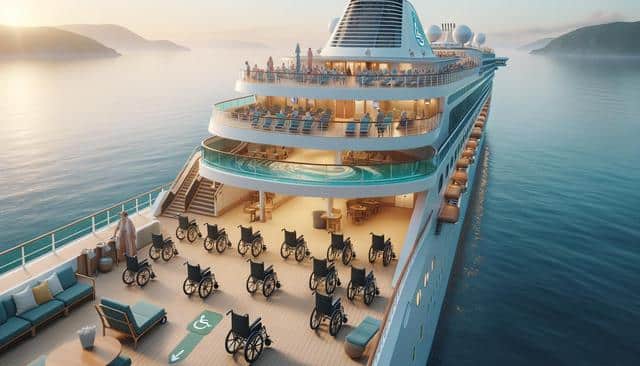
Exploring the Seas with Ease: A Guide to Wheelchair-Friendly Cruises
Understanding Accessibility at Sea
Cruise lines have made significant strides in recent years to accommodate travelers with mobility challenges. Wheelchair-friendly cruises are designed with inclusivity in mind, offering features that ensure all guests can enjoy their vacation comfortably. These ships often include accessible staterooms with wider doorways, roll-in showers, grab bars, and lower closet rods. Beyond the rooms, accessibility continues in public areas, such as theaters, dining venues, and lounges where ramps and elevators are available.
It’s important to understand that accessibility features can vary between ships, even within the same cruise line. When researching, travelers should review the cruise line’s accessibility policies or contact their accessibility department directly. Asking specific questions about door widths, bathroom layouts, and accessible shore excursions can help avoid surprises later. Booking early is also advisable, as accessible cabins are limited and in high demand.
Features to Look for in an Accessible Cruise
When selecting a cruise, there are several key features to consider that can enhance the experience for wheelchair users. These include:
- Stateroom accessibility: Roll-in showers, grab bars, lowered sinks, and turning space for mobility devices.
- Accessible dining: Tables with space for wheelchair access and accessible buffet arrangements.
- Public area access: Elevators, automatic doors, step-free venues, and designated seating areas in theaters.
- Shore excursion options: Excursions that accommodate wheelchairs, including transport and activity access.
Many cruise lines also offer equipment rentals, such as mobility scooters or shower chairs, which can be reserved ahead of time. Pre-boarding assistance and priority embarkation are often available for those who need them. Additionally, some ships provide accessible pools with lifts, and fitness centers with adaptive equipment.
Planning and Booking Your Cruise
Planning a wheelchair-friendly cruise involves careful research and communication. Start by identifying cruise lines and ships known for their accessible offerings. Travel agents who specialize in accessible travel can be a valuable resource, as they are familiar with the details that matter most for mobility-impaired passengers.
When booking, it’s important to:
- Request a wheelchair-accessible cabin early in the process.
- Inform the cruise line of any specific mobility needs at the time of booking.
- Inquire about accessible transportation from the airport or hotel to the port.
- Check for accessible shore excursions and onboard activities.
Documentation may be required to ensure proper accommodations are made, so keep medical and mobility information readily available. Also, be prepared to verify the size of your wheelchair or scooter, as some ships have limitations on device dimensions in certain areas.
Onboard Experience and Accessibility Support
Once on board, passengers using wheelchairs will find a range of services tailored for comfort and independence. Crew members are typically trained to assist guests with mobility challenges, and many cruise lines offer dedicated accessibility staff to help throughout the voyage. From embarkation to disembarkation, the experience is designed to be as seamless as possible.
Entertainment venues usually have designated accessible seating, and some ships offer closed captioning or assisted listening devices for shows. Dining can also be a smooth experience, with staff ready to help navigate buffets or deliver meals directly to the table if needed. It’s helpful to explore the ship early in the cruise to become familiar with accessible routes and facilities.
For those who wish to explore ports of call, many cruise itineraries now include destinations with improved infrastructure, allowing for easier access to attractions. However, accessibility can vary greatly between ports, so reviewing excursion details in advance is essential.
Tips for a Smooth Sailing Experience
To make the most of a wheelchair-friendly cruise, preparation is key. Here are some helpful tips to ensure a comfortable and enjoyable journey:
- Bring necessary medical supplies and mobility aids, as availability on board may be limited.
- Label your wheelchair or scooter clearly with your name and contact information.
- Download or carry a map of the ship highlighting accessible routes and facilities.
- Engage with onboard accessibility staff to address any concerns or needs promptly.
Consider joining online forums or social media groups focused on accessible cruising. Many travelers share valuable insights and reviews about specific ships and itineraries. These real-life experiences can offer guidance that goes beyond what’s listed in brochures or websites.
Finally, approach the trip with flexibility. While most cruise lines strive to offer inclusive experiences, unexpected challenges may arise. A positive mindset and open communication with staff often lead to quick solutions and a rewarding travel adventure.
Conclusion: Inclusive Travel for All
Wheelchair-friendly cruises provide a meaningful way for individuals with mobility challenges to explore the world without limits. With growing awareness and evolving ship designs, cruising is becoming more inclusive, offering a comfortable and enriching experience for all guests. By planning ahead, asking detailed questions, and utilizing available resources, travelers can enjoy a vacation that meets their needs while delivering the joy and relaxation cruising is known for.


